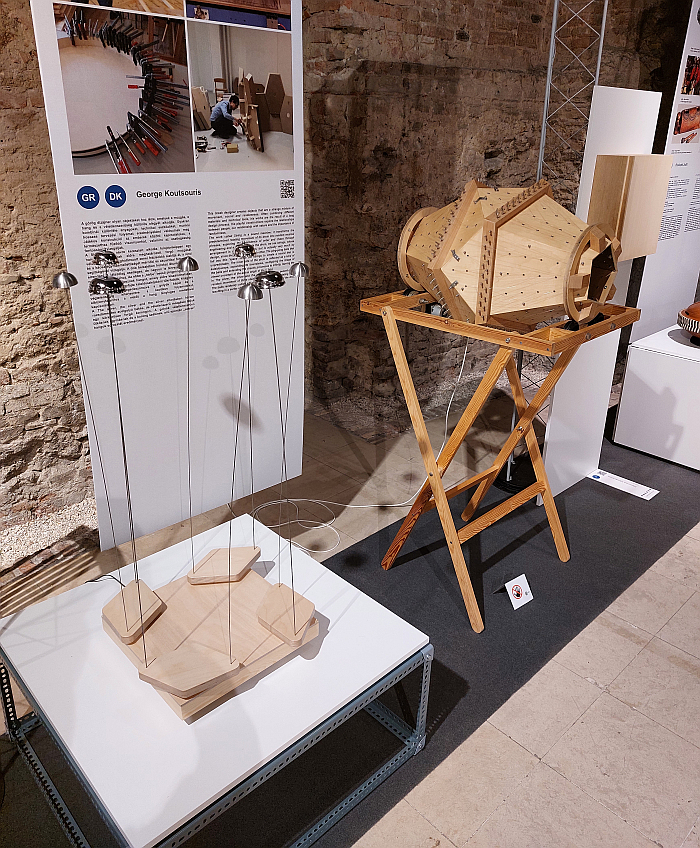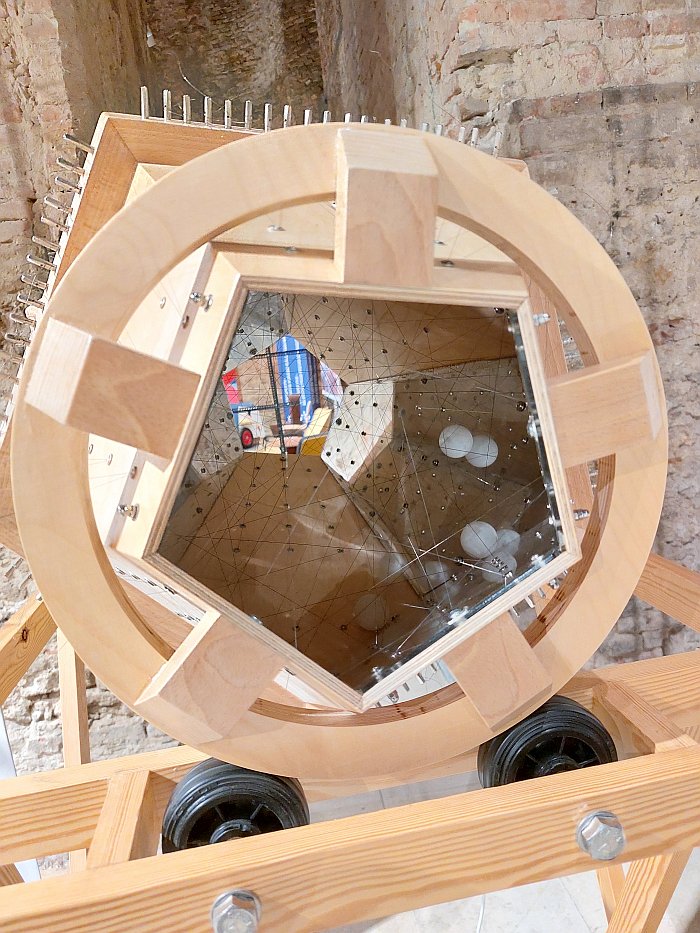
In 2023 a, if one so will, special edition of Design Without Borders was held at FUGA - Budapest Center of Architecture, which devoted itself to "sound objects", objects that deliberately emit sounds, can be made to emit sounds, but which aren't musical instruments, or at least not in the normally understood definitions of the term; sound objects that, in many regards, are also part of that discussion on the differences between noise, sound and music that could be followed and contributed to in context of Sound Sources. Everything is Music! at the Weltkulturen Museum, Frankfurt.
For the 2024 edition of Design Without Borders some of those sound objects, and their creators, were invited back including Greek born, Danish based, George Koutsouris, a mechanical engineering graduate of the National Technical University, Athens, acoustics graduate of the Technical University of Denmark, Lyngby, and Masters graduate of the Royal Danish Academy of Fine Arts, Copenhagen, who also trained as a musician at the National Conservatory of Greece and the Philippos Nakas Conservatory, Athens, and who is and was presented at Design Without Borders 2024 by two works: one of which is a new creation for Design Without Borders 2024, but both of which may well be. During the process of writing this we've suddenly become very unsure.
Two projects which although they may appear very different, are very different, structurally, functionally, aurally, take you in very similar, identical, directions. Compliment and support one another in guiding you and your thoughts.
The first, String, which may or may not be new, but very much is a revolving drum, open at both ends and whose interior is lined with mirrors, creating a sensation of endlessness as it turns. A revolving drum whose interior is also criss-crossed by metal strings of the type one might find on a guitar, piano or other stringed instrument, in which context, String also, and satisfyingly so, resembles some non-existent, but very popular, vernacular string instrument; strings which traverse the space without touching one another to form a disconnected weave. A mirror lined, string woven interior that is also home to a number of ping-pong balls, which nest supported by a string and the outer wall, and occasionally by another ping-pong ball, until the rotation of the drum causes them to fall through one of the myriad gaps, pitfalls, between the strings that has suddenly appeared below them, and thus, almost invariably, to make contact with a string, or with several strings, thereby generating a sound. Before nesting on a string, until a gap, pitfall, appears below them. Ad infinitum as the open-ended drum rotates.
The second, Sonic Flowers, very much is new, and, as the name implies, is, to paraphrase William Wordsworth, 'a host, of silver steel bells atop steel wires' but which rather than "fluttering and dancing in the breeze", flutter and dance on the rotating diamond shaped wooden blocks out of which they grow; diamond shaped blocks whose rotations nonetheless cause them to toss "their heads in sprightly dance"........ Yes, we probably did overdo the Wordsworth there, sorry, shouldn't have happened, we got a bit carried away by the 'dances with the steel bells atop steel wires'. Sorry! Again! A dance of steel bells, technically, and conceptually importantly, two typologies of steel bell, two tone families, atop thin steel wire stems that means from time-to-time two bells connect, collide, and ring out. Often nothing happens for a long period, then something, nothing, something. A lot. Nothing. A lot. Nothing. Ad infinitum as the diamond shaped wooden blocks rotate.
Two objects which thus in their own way contribute to the above noted discussion on the differences between noise, sound and music: for some that which they will be one, for some the other and for yet others the third. But how are you defining that which you hear? On what are you basing your classification? Why not the others?
Two object that are however much more.
Two objects which cause you, certainly caused and cause us, to reflect on that other Greek born, National Technical University Athens Engineering Department alumni, generator of noise, sound and music, Iannis Xenakis. Yet whereas a Xenakis employed all manner of complex mathematics, Le Corbusierian proportions and high-tech wizardry, if largely pre-digital high-tech wizardry, to produce his noise, sound, music, to employ randomness and serendipity as his co-composer, George Koutsouris relies on pleasingly simple low-tech objects to initiate, employ, chaos and disorder; objects which express themselves with an apparent naivety, without being child-like, although we can well imagine both, in different contexts, in any nursery, objects apparently quickly knocked together in a shed from that which was lying around. Apparently. Apparently. George's sound objects are however highly refined and thoughtful objects that are as diligently and conscientiously conceived and constructed as the compositions of a Xenakis: just very simple and via the simplest of means. A simplicity which helps underscore that George's sound objects aren't about the 'objects', charming and engaging as they are, but about the 'sound', about that which the sound "to me had brought", a giving that while without question can, and in our case will, comfort us 'when on our couch we lie, In vacant or in pensive mood' ... sorry but we appear to be very much stuck in a Wordsworth moment here, apologies, but we are fortunately running out of text from I Wandered Lonely as a Cloud to quote ... but a giving from Sonic Flowers that is more important for the dialogue and discourse it stimulates, demands.
And a simplicity of design that also allows for an easy comparison of George Koutsouris's sound objects with, for example, the sound sculptures of a Harry Bertoia, objects that often take simplicity of design to unknown levels. Albeit in Bertoia's works there is invariably the necessity for an active human-sculpture interaction to produce a sound. George's rely on chance. But then, don't we all.
The randomness, unpredictability, pure chance inherent within and defining String and Sonic Flowers poetically echoing the randomness, unpredictability, pure chance of life: not just that no-one can prophetise or control when a sound will be generated, but with every cling and ting and ding the bells' and ping-pong balls' direction is changed, every sound, every connection, every interaction, influences all future possible sounds, connections, interactions, without directly informing and defining that future sound; a future sound, as it is, also dependent on the other components of the system and the connections and interactions and sounds they make. Random. Unpredictable. Pure chance. Ad infinitum.
Thus String and Sonic Flowers help on the one hand underscore that no matter how carefully we plan, a great many things happen outwith our control which will invariably impact on our plans, we are, collectively and individually, components of wider systems we impact upon and which impact upon us; and on the other help reinforce the arguments made by Perfectly Imperfect. Flaws Blemishes and Defects, Gewerbemuseum, Winterthur, that not only is perfection limiting, harmful, but as a society, as individuals, we need, we are dependent upon, imperfection, we need, are dependent upon, serendipity. And appreciating such, embracing such, celebrating such, is going to be important going forward. Appreciating, embracing, celebrating the inevitability of chaos as a key to the future survival of human society, rather than trying to organise to the minutest detail. The answers aren't on a spreadsheet. Or in an app. They're falling through a string spun, mirror lined, revolving drum. And atop a thin steel wire stem rotating on a diamond base.
Considerations, and a questioning, which also enable String and Sonic Flowers to contribute to the important, but all to rarely undertaken, discourses on the relationships between the aural world and the physical world, on the relationships between the immateriality of music and the immateriality of society and self, on the need to redefine 'existence' in context of the developments and changes of the past millennia, as much as the need to redefine 'music' in context of those changes; how do you define what you hear, how do you classify noise, sound and music? Why? And why your definition of 'existence'?; objects which allow one to swap 'music' for "the decisions you make" in a Giorgio Moroder's "once you free your mind about a concept of ‘harmony’ and of music being ‘correct’, you can do whatever you want".1 Which, yes, could, but needn't, bring you back to Søren Kierkegaard. Keeps you however by Giorgio Moroder. Giorgio Moroder invented disco.2 What will you do?
And objects which also tend to admonish that if you walk through life with your headphones permanently on, and on, be they physical headphones or conceptual headphones, you're missing out an awful lot. We need those background sounds of life, we need the interactivity with the background sounds of life, not just your own tune, ad infinitum.
But for all String and Sonic Flowers, with their naivety and simplicity and persistent, intense questioning and clings, tings, dings are objects which 'a sentient being could not but be gay, In such a jocund company', being as they are works which 'our heads with innumerable thoughts, associations and differentiated perspectives fills'.
More information on George Koutsouris and his work can be found at https://georgekoutsouris.com including a video of Sonic Flowers in action.
And more details on Design Without Borders, including information on the 2024 edition, can be found at https://design-without-borders.eu

1Daft Punk, Giorgio by Moroder, Random Access Memories, 2013 Quote comes at around 5 minutes, just before Daft Punk, inspired by Moroder, do whatever they want
2The claim that Giorgio Moroder "invented disco" is very much one open to discussion and debate, nothing is that that clear cut. However no-one can argue that the work Moroder undertook in his Munich studio wasn't of fundamental importance for what came after it. Or you could, but you'd be wrong.